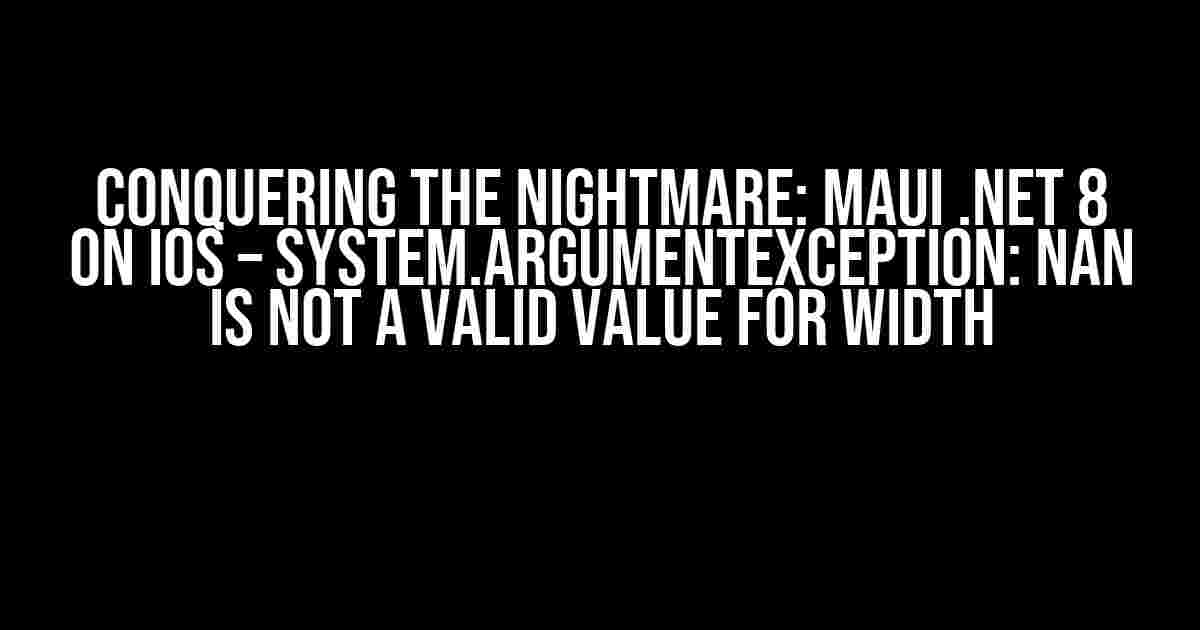Are you tired of encountering the dreaded System.ArgumentException: NaN is not a valid value for width error while developing your MAUI .NET 8 app on iOS? Well, you’re in luck! This article is here to guide you through the troubleshooting process and provide you with a comprehensive solution to overcome this frustrating issue.
Understanding the Error
Before we dive into the solution, let’s take a step back and understand what’s causing this error. The System.ArgumentException: NaN is not a valid value for width error typically occurs when the MAUI framework is unable to determine the width of a visual element, resulting in a NaN (Not a Number) value. This can happen due to a variety of reasons, including:
- Incorrect or missing width and height values for visual elements
- Incorrect layout configurations
- Conflicting styles or properties
- Missing or corrupted Xamarin.Forms NuGet packages
Preparation is Key
Before we begin troubleshooting, make sure you have the following essentials in place:
- MAUI .NET 8 installed: Ensure you have the latest version of MAUI .NET 8 installed on your development machine.
- Xamarin.Forms NuGet packages: Verify that you have the correct Xamarin.Forms NuGet packages installed in your project.
- iOS simulator or device: Have an iOS simulator or a physical iOS device ready for testing.
- Basic understanding of MAUI .NET 8 and Xamarin.Forms: Familiarize yourself with the basics of MAUI .NET 8 and Xamarin.Forms to better understand the troubleshooting process.
Troubleshooting Steps
Step 1: Verify Width and Height Values
Review your XAML code and ensure that you have correctly set the width and height values for all visual elements. Check for any Binding or Style conflicts that might be causing the issue.
<StackLayout>
<Label Text="Hello, World!"
WidthRequest="100"
HeightRequest="50" />
</StackLayout>
Step 2: Inspect Layout Configurations
Examine your layout configurations and ensure that they are correctly set up. Look for any conflicting or missing layout options that might be causing the error.
<StackLayout>
<StackLayout.Orientation>
<OnPlatform x:TypeArguments="LayoutOrientation">
<OnPlatform.Platform>ios</OnPlatform.Platform>
<OnPlatform.Value>Vertical</OnPlatform.Value>
</OnPlatform>
</StackLayout.Orientation>
</StackLayout>
Step 3: Check for Conflicting Styles or Properties
Review your styles and properties to ensure that there are no conflicting or duplicate values. Check for any styles or properties that might be overriding the width or height values.
<Style TargetType="Label">
<Setter Property="WidthRequest" Value="100" />
<Setter Property="HeightRequest" Value="50" />
</Style>
Step 4: Verify Xamarin.Forms NuGet Packages
Ensure that you have the correct Xamarin.Forms NuGet packages installed in your project. Check for any missing or corrupted packages that might be causing the issue.
| Xamarin.Forms NuGet Package | Version |
|---|---|
| Xamarin.Forms | 8.0.0.328 |
| Xamarin.Forms.Core | 8.0.0.328 |
| Xamarin.Forms.Platform.iOS | 8.0.0.328 |
Solution: MAUI .NET 8 Fix
After going through the troubleshooting steps, if you’re still encountering the System.ArgumentException: NaN is not a valid value for width error, it’s time to implement the MAUI .NET 8 fix.
Step 1: Update MAUI .NET 8
Ensure you’re running the latest version of MAUI .NET 8. Update your project to the latest version if necessary.
Step 2: Add the MAUI .NET 8 Fix
Add the following code to your iOS renderer to fix the issue:
using Xamarin.Forms.Platform.iOS;
public class CustomRenderer : ViewRenderer<View, UIView>
{
protected override void OnElementChanged(ElementChangedEventArgs<View> e)
{
base.OnElementChanged(e);
if (e.NewElement != null)
{
SetWidthAndHeight(e.NewElement);
}
}
private void SetWidthAndHeight(View view)
{
var width = view.WidthRequest;
var height = view.HeightRequest;
if (double.IsNaN(width) || double.IsNaN(height))
{
view.WidthRequest = 100;
view.HeightRequest = 50;
}
}
}
Step 3: Apply the MAUI .NET 8 Fix
Apply the custom renderer to your iOS project by adding the following code to your AppDelegate.cs file:
using Xamarin.Forms.Platform.iOS;
[Register("AppDelegate")]
public partial class AppDelegate : global::Xamarin.Forms.Platform.iOS.FormsApplicationDelegate
{
public override bool FinishedLaunching(UIApplication app, NSDictionary options)
{
global::Xamarin.Forms.Forms.Init();
LoadApplication(new App());
return base.FinishedLaunching(app, options);
}
}
Conclusion
By following the troubleshooting steps and implementing the MAUI .NET 8 fix, you should be able to resolve the System.ArgumentException: NaN is not a valid value for width error and get your MAUI .NET 8 app up and running smoothly on iOS.
Remember to stay vigilant and keep an eye out for any other issues that might arise during development. Happy coding!
Additional Resources
For further assistance and guidance, check out the following resources:
Frequently Asked Question
Get the answers to the most frequently asked questions about “MAUI .NET 8 on iOS – System.ArgumentException: NaN is not a valid value for width”
Why am I getting ‘System.ArgumentException: NaN is not a valid value for width’ error in MAUI .NET 8 on iOS?
This error typically occurs when the width or height of an element is set to ‘NaN’ (Not a Number). In MAUI .NET 8 on iOS, this can happen due to a layout issue or when trying to set a size that is not valid. Make sure to check your XAML code and ensure that the width and height values are correctly set.
How do I fix the ‘System.ArgumentException: NaN is not a valid value for width’ error in MAUI .NET 8 on iOS?
To fix this error, you need to identify the element that is causing the issue and ensure that its width and height values are correctly set. Check for any bindings or calculations that may be resulting in ‘NaN’ values. You can also try setting a default value or using a converter to handle invalid input.
What is the most common cause of ‘System.ArgumentException: NaN is not a valid value for width’ error in MAUI .NET 8 on iOS?
The most common cause of this error is when a Grid or other layout container has a row or column definition with a width or height set to ‘Auto’ or ‘*’, and there is no content to define the size. This can also happen when using a binding that returns ‘NaN’ or when trying to set a size that is not valid.
Can I use a try-catch block to handle the ‘System.ArgumentException: NaN is not a valid value for width’ error in MAUI .NET 8 on iOS?
While it is possible to use a try-catch block to catch the exception, it’s not recommended as the best approach. Instead, you should identify and fix the underlying issue that is causing the error. Catching the exception may just mask the problem, and it may still cause issues with your app’s layout and functionality.
Are there any workarounds for the ‘System.ArgumentException: NaN is not a valid value for width’ error in MAUI .NET 8 on iOS?
If you’re unable to identify the root cause of the error, you can try setting a default width or height value for the affected element. You can also use a converter to handle invalid input or try setting the size using a custom renderer. However, it’s essential to note that these are just workarounds, and you should still try to identify and fix the underlying issue.


